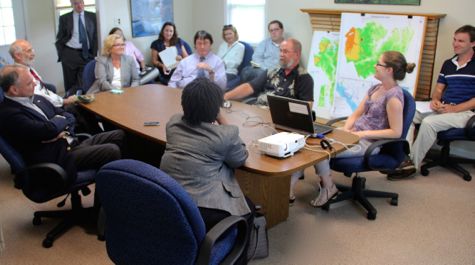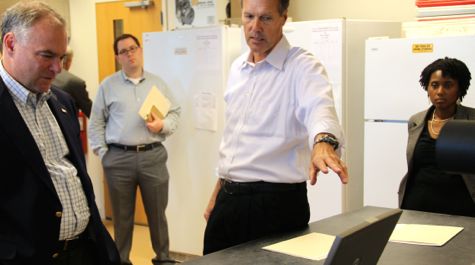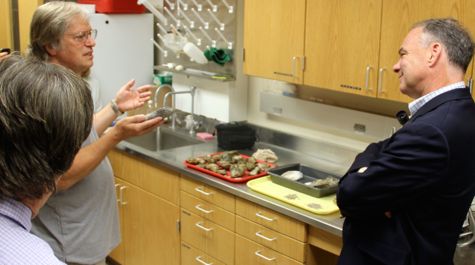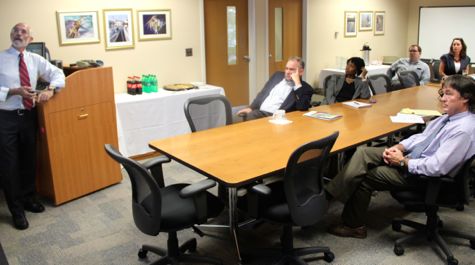Senator Kaine visits VIMS
Former Virginia Governor explores sea-level rise, blue crabs, oysters
U.S. Senator Tim Kaine visited the Virginia Institute of Marine Science on August 25th to learn about three topics of special concern to citizens of the Commonwealth: sea-level rise, blue crabs, and oysters.
The visit was part of the Senator’s two-week tour of key sites throughout Virginia during the current Congressional recess.
“Tim Kaine has been a good friend to VIMS since his time as Governor,” says Dean and Director John Wells, who hosted the Senator during his tour of VIMS' Gloucester Point campus. “We were glad for the opportunity to update him on our ongoing research into issues that are critically important to Virginia’s environment and economy.”
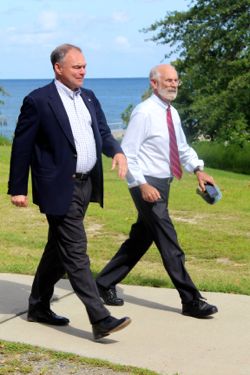 Wells began the tour with a brief overview of VIMS, which touched on the Institute’s mandated role as a scientific advisor to the Commonwealth; the effects of recent and upcoming budget cuts; and the important role that graduate students in William & Mary’s School of Marine Science at VIMS play in research and advisory service.
Wells began the tour with a brief overview of VIMS, which touched on the Institute’s mandated role as a scientific advisor to the Commonwealth; the effects of recent and upcoming budget cuts; and the important role that graduate students in William & Mary’s School of Marine Science at VIMS play in research and advisory service.
Sea-Level Rise
Kaine and his staffers then visited VIMS’ Center for Coastal Resources Management, where Professor Carl Hershner and researcher Molly Mitchell discussed the science behind projections of an accelerating rise in sea level for the region, the online tools they’re developing to help visualize and combat the threat, and their collaboration with the W&M Law School in helping local governments frame an effective response.
“Seeing VIMS' research underscores that sea-level rise is a today issue in this region, not a tomorrow issue,” said Kaine. "We’re dealing with the effects of climate change every day in Virginia and in Congress—from rewriting the federal flood insurance program, to Hurricane Sandy relief, to people in Norfolk using apps on their phones to check whether their streets will flood. I'm grateful for the groundbreaking work done by VIMS, which will be invaluable as communities, states, and the federal government plan for the future.”
Blue Crabs
Kaine next met with Professor Rom Lipcius, who oversees VIMS’ participation in the Blue Crab Winter Dredge Survey, the primary tool for tracking the status of the blue crab population in Chesapeake Bay. Lipcius described the science behind recent management actions related to blue crabs, and the factors responsible for the ups and downs observed in the Bay’s blue crab population since 2008, when then-Governor Kaine and management agencies in Virginia and Maryland made the difficult decision to close the winter dredge fishery.
“It’s very clear that the population responded to the management actions,” said Lipcius. “The female segment of the population went up right after they went into place, very close to what we consider the target—just where we would like to be with the most productive state of the fishery.”
Unfortunately, that population spike did not persist, with the number of female blue crabs in the Bay dropping to troubling levels again in 2012. Lipcius attributes the observed decline to a “once-in-a-50-year explosion of red drum,” a voracious blue crab predator, along with background predation by other fish such as striped bass and blue catfish.
“The management actions that were implemented are working,” said Lipcius, “but now we are suffering from the vagaries of the environment. The scientific community and the managers are cautiously optimistic about the blue crab recovery, but we know that we need to continue risk-adverse management. We did see a small increase in females last year, and hope to see that continue.”
Oyster Restoration
Kaine’s final visit was to the laboratory of Professor Roger Mann, who explained the long-term learning curve behind Virginia’s recent successes in oyster restoration. Mann noted that oysters are rare among marine species in creating their own habitat—reefs—from shell that accumulates as oysters die. Mann stressed that restoring depleted oyster populations and managing active fisheries requires knowledge of the dynamics of both the living component of the reef—the oysters—as well as the processes that lead to shell accumulation, burial, and loss.
“Long-term collaborative efforts between VIMS and VMRC have led to an increased understanding of both dynamic processes,” said Mann, “and we now manage resources on a river-specific basis to maximize production while stabilizing the underlying habitat.” Virginia’s overall oyster production has increased 12-fold in the past decade from public and leased bottom harvest, and now exceeds 530,000 bushels per year with a dockside value in excess of $21 million.
Science and Policy
Responding to fiscal questions from reporters following his visit, Kaine made a strong case for support of VIMS and other scientific institutions in Virginia.
“We have to find ways to develop other industries so that we are not overly reliant on federal investment,” said Kaine. “Investment of a public research dollar that helps a private aquaculture business grow is part of diversifying the economy. What we see with aquaculture in Virginia—we are the number one producer of cultured clams and might be producing the highest dollar value of oysters of any state in the next 10 years—there’s an example of a wise public investment. It’s helping to expand an economic opportunity that is a great thing for Virginia’s economy, and ties into our history. It's a great Virginia industry that we are bringing back through wise R&D spending.”
Kaine also told the VIMS researchers about the importance he places on using science to inform policymaking. “You served me as Governor exactly in accord with your mission as science advisors,” said Kaine. In two particular instances—closing the dredge fishery for blue crabs and deciding against introduction of a non-native oyster—Kaine noted the science pointed to decisions that were politically difficult, but have benefitted the Commonwealth in the long run.


